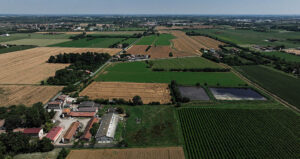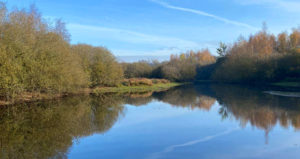Intensive dairy agriculture major polluter of Europe’s surface waters

-
 Fergal MacErlean
Fergal MacErlean
Share article:
Despite some improvements, water pollution remains a key environmental challenge across the EU and globally, with agriculture being a major contributor to high levels of nutrients such as nitrates and phosphorus, and pesticides. Investigative journalists Fergal MacErlean and Cecilia Fasciani researched the relation between intensive dairy agriculture in Europe, with a focus on Ireland and Italy.
The region’s almost 100,000 surface water bodies (streams, rivers, lakes, wetlands, and reservoirs) and 12,000 groundwater bodies are vital as a source of drinking water and for healthy ecosystems. Excess nutrients, from farming or poor waste water treatment, causes eutrophication, an overgrowth of plants and algae. This depletes oxygen levels in the water and harms sensitive aquatic life disrupting the ecological balance. Alarmingly, while unpolluted freshwater systems are essential for humans these have become the most degraded ecosystems in the world due to a host of factors.
Eutrophication
Agriculture uses nitrogen and phosphorus in manure and inorganic fertilizers to increase plant yields. The European Commission found that the sector is responsible for 77% of the total load of nitrogen into the environment. In line with the Nitrates Directive, set up to combat excess nitrogen from agriculture, Member States have to monitor the quality of the waters and to identify areas that drain into polluted waters or which are at risk of pollution. This includes waters that are eutrophic due to agricultural activities or contain, or could contain, a concentration of more than 50 mg/l of nitrates, areas defined as Nitrate Vulnerable Zones. Excess phosphorus is also covered by the directive. Both phosphorous and nitrogen play a role in eutrophication, but while the main cause of this process in fresh water is phosphorus, it is mainly caused by nitrogen in marine water. Between 2016-2019, across Member States, 14.1% of groundwater still exceeded the nitrates concentration limit set for drinking water. According to a Danish study nitrates in water can also increase the risk of colorectal cancer.
Dairy production
The dairy production sector is responsible for a large share of environmental impacts, including greenhouse gas emissions, groundwater pollution, and excessive freshwater and marine nutrient pollution from the poor handling of urine, manure and fertilizers. This latter problem is exacerbated with low river levels due to climate change such as has been seen in northern Italy. And, across western Europe, some 25% of the nitrogen in animal excretion is lost to the atmosphere and can impact human health.
Nutrient pollution
Nitrate concentrations have fallen in both surface and groundwater in the EU compared to the situation prior to the adoption of the Directive in 1991. However, the European Commission’s latest report reveals that little progress has been made over the last decade and nutrient pollution from agriculture is still a serious concern for many Member States. In a briefing the EU’s European Environment Agency acknowledges that nitrate vulnerable zones received Commission-sanctioned exemptions, known as derogations, to farm at higher stocking densities in spite of the science. “Although the problem has been known for a long time, at the end of 2015 there were still derogations in place from the maximum amount of 170 kg of nitrogen per hectare per year from livestock manure in nitrate vulnerable zones for Ireland and Emilia Romagna, Lombardia, Piemonte and Veneto in Italy, among other regions and countries,” the agency states. EU countries are the second-largest milk producers in the world, after India, with some 20 million dairy cows in 2020. In 2022 the milk market was worth approximately €50 billion. The EU dairy herd has been decreasing in recent years as the milk yield per cow has improved.
Remote sensing can chart pollution
Since 2015, when the EU’s dairy quota was abolished, it has been common for farmers to intensify their production. Some countries, such as Ireland, Germany, and the Netherlands, started to produce more dairy products for export, which has led to overproduction. Milk production, estimated to be around 155 million tonnes per year, represents a significant proportion of the value of EU agricultural output and has a formidable lobby. The main producers are Germany, France, Poland, the Netherlands, Italy and Ireland which account for almost 70% of EU milk production. A dearth of inspectors in Italy and Ireland means many pollution incidents go unreported. Remote sensing could support Member States on their assessment of algal blooms and satellite imagery can be used to detect over-fertilised fields with the potential for enforcement measures.
Intensification of dairy farming
In Europe dairy farming typically uses a mixed system with grasslands for livestock grazing and fields for producing crops for humans or livestock. Livestock manure is then used as crop fertiliser. Farmers may add concentrates to increase milk yields. The intensification of dairy farming has required ever growing quantities of fuel oil, fertilizer, commercial feed and other inputs, leading to greater environmental impacts. Due to increased milk production costs, dairy cow numbers in the EU are forecast to fall below 20 million in 2023, a decline of 1.7 million since its peak in 2016, and a decrease of 564,000 since 2021.

Farm closures
In the Netherlands the Dutch government wants to reduce dairy cow numbers by 20-30% and cut nitrogen pollution in half after the country’s agricultural sector was linked to a massive nitrogen and phosphate problem sparking farmers’ protests. Forced farm closures remain a possibility there if several hundred voluntary ones do not transpire. The situation is similar to Flanders where the regional government is seeking farm closures in a bid to cut nitrogen levels by half by 2030.
Water News Europe is publishing a LONGREAD of European investigative journalists on pressing water issues in various Member States. The first article will paint the European picture. The following story will focus on agricultural pollution in Ireland and the last article will sketch out the situation in Italy.
This article was developed with the support of Journalismfund Europe

















